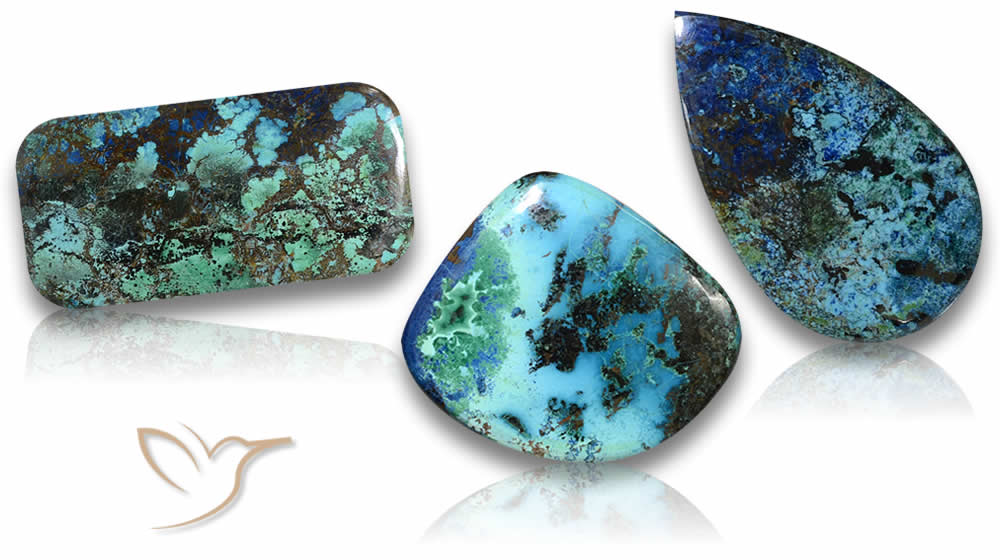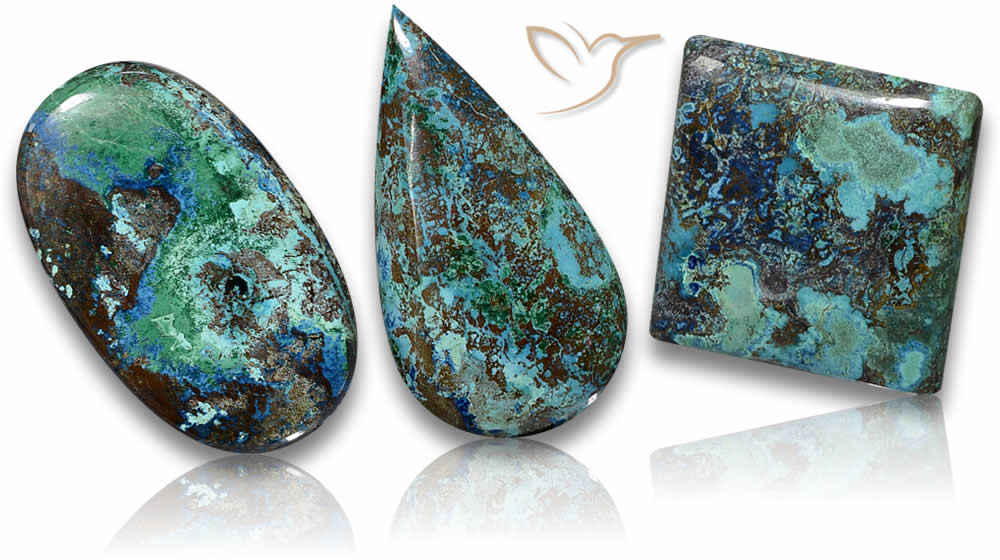Azurite Gemstone Information: Unveiling Beauty

Welcome to our comprehensive guide to the fascinating azurite gemstone. This stunning gem is renowned for its deep, alluring blue color and is known for its incredible healing and metaphysical properties. In this article, we will explore everything you need to know about azurite, from its characteristics and uses, to its symbolic meaning and spiritual significance.
Explore our stock of azurite gemstones right here.
Key Takeaways:
- Azurite is a captivating gemstone with a deep blue color.
- It is known for its powerful healing and metaphysical properties, promoting emotional healing and stimulating the Third Eye Chakra.
- Azurite is a popular gemstone for jewelry, including rings, necklaces, earrings, and bracelets.
- Careful maintenance and storage are essential to preserve the beauty and longevity of azurite jewelry.
- Embrace the transformative power and beauty of azurite in your daily life.
Azurite Gemstone Characteristics
If you're fascinated by the beauty of the azurite gemstone, it's essential to explore its distinct characteristics. One of the most apparent features is its vibrant blue color, ranging from light blues to deep, intense hues that can be almost purple. The beautiful color of azurite gemstones has historically been used to represent both heaven and water, making it a symbol of purity and calm.
Azurite is a copper mineral, forming naturally in the oxidized zone of copper ore. Due to its association with copper deposits worldwide, it is found in different parts of the world. The largest known deposit is found in the southwestern United States, in Arizona and New Mexico. Other significant deposits can be found in Australia, Russia, Zimbabwe, and Namibia, among others.
Another interesting characteristic of azurite is its unique crystal structure, which grows in different shapes such as tabular, prismatic, or globular. This feature gives added depth and texture to the gemstone, making it an ideal choice for jewelry pieces or display in mineral collections.
Now that you know more about the most outstanding features of azurite gemstones, let's move on to the healing and metaphysical properties that make this gemstone so special.
Azurite Healing and Metaphysical Properties
Azurite is a potent gemstone renowned for its healing and metaphysical properties that can impact every aspect of your life. From emotional to spiritual growth, this beautiful stone can help align and balance your energies, leading to numerous benefits.
Intuition and Awareness: Azurite is known for its ability to stimulate the Third Eye Chakra, enhancing intuition, spiritual awareness, and psychic abilities. It nurtures your inner wisdom, allowing you to recognize your true self and empowering you to make insightful decisions.
Emotional Healing: Azurite can help to soothe anxious thoughts, promote emotional balance, and encourage self-expression by releasing tension and frustration. It helps cultivate deep inner peace and healing from emotional wounds, guiding you towards a more positive outlook on life.
Spiritual Growth: Through the powerful energy resonance of azurite, this gemstone can elevate your spiritual growth, strengthening your connection with the divine, nature, and the universe. It helps gain clarity and insight into your deeper purpose in life, leading to a sense of fulfilment and spiritual awakening.
Other Azurite Gemstone Benefits: Apart from its healing and metaphysical properties, azurite is also associated with physical benefits such as improved circulation, detoxification, and reduced inflammation and pain. Incorporating azurite into your meditation or daily routines can provide significant benefits for your mind, body, and soul.
| Azurite Crystal Facts | |
|---|---|
| Color: | Deep blue, Azure, Greenish-blue |
| Chakra: | Third Eye Chakra, Crown Chakra |
| Zodiac Sign: | Sagittarius, Aquarius |
| Element: | Water, Air |
| Origin: | USA, Chile, France, Morocco, Namibia, Australia, China |
Azurite Spiritual Properties
Of all the beautiful gemstones in the world, azurite holds a significant spiritual significance that transcends time and space. Associated with wisdom, insight, and transformation, this gemstone can provide a sense of calmness and balance, leading to spiritual growth and enlightenment. It is believed to help in:
- Explore spiritual realms and higher dimensions
- Attain inner peace and harmony
- Achieve spiritual awakening and enlightenment
- Connect with your true self and inner wisdom
If you're seeking spiritual growth or enlightenment, azurite is an excellent gemstone to add to your collection.
Azurite Uses and Jewelry
Azurite is a popular gemstone that is widely used in jewelry. Its deep blue color and unique crystalline structure make it a stunning addition to various pieces, ranging from rings to necklaces, earrings to bracelets. At the same time, this gemstone is also a popular choice for collectors, who appreciate its unique metaphysical and healing properties.
Different Types of Azurite Jewelry
When it comes to azurite jewelry, there are various types and styles available. One of the most popular selections is azurite rings, which can be worn by both men and women. These can come with azurite gemstones in different sizes and shapes, and can be set in a variety of metals such as gold, silver, or platinum.
Azurite necklaces and pendants are also popular, particularly for their ability to sit close to the heart chakra. These can come with single or multiple stones, and can be plain or elaborate, depending on preference.
Earrings are a great way to add a touch of azurite to an outfit. They come in different styles such as studs, hoops, and danglers to suit every taste. Similarly, azurite bracelets are a great way to showcase this beautiful gemstone, adding a pop of color to any wrist.
Wearing Azurite Jewelry
When wearing azurite jewelry, it is essential to keep in mind its energy and healing properties. Some people believe that the gemstone is particularly powerful when worn close to the skin or when placed on the Third Eye Chakra. However, the beauty of azurite is that it can be worn in any way that suits you, be it simply for beauty or for its other benefits.
Caring for Azurite Jewelry
Proper care is important to maintain the beauty of azurite jewelry. Although it is a relatively durable gemstone, it is still susceptible to scratches and damage if treated roughly. It is recommended to store azurite jewelry separately, away from other jewelry pieces that may cause scratches. You can also clean it gently with a soft brush and mild soap in lukewarm water, and dry it with a soft cloth.

Azurite Gemstone Care
To ensure your azurite gemstone remains beautiful and dazzling for many years, proper care is essential.
Cleaning Tips
It is recommended to clean your azurite gemstone using a soft, dry cloth. Avoid using any harsh chemicals or cleaners as they can damage the stone. If necessary, a mild soap and water solution can be used, but be sure to rinse the stone thoroughly and dry it completely with a soft cloth. Never soak your azurite gemstone in water or any other liquid as this can also cause damage.
Storage Tips
When storing azurite gems or jewelry, it is important to keep it away from other jewelry that may scratch or damage the delicate stone. The ideal storage solution is a soft pouch or lined jewelry box to prevent any potential damage.
Wearing Tips
Avoid wearing azurite jewelry during physical activities or when there is a high risk of impact, such as working with heavy machinery. This will help prevent accidental damage to the stone.
Final Tips
While azurite is relatively durable, it is important to treat it with care to ensure its longevity. Regularly cleaning, storing, and wearing the gemstone properly will help maintain its beauty for years to come.
Azurite Gemstone Information: A Captivating Beauty
Throughout this article, we’ve explored every aspect of the stunning azurite gemstone. From its characteristics, healing and metaphysical properties, and uses in jewelry, we’ve uncovered the many facets of this captivating gem.
However, beyond its aesthetic beauty and transformative properties, azurite holds a deep spiritual significance. As a stone that represents inner wisdom, intuition, and spiritual growth, it can guide us on our journey to self-discovery and enlightenment.
Whether you’re drawn to azurite for its stunning blue hues or its profound meaning, incorporating this gemstone into your life can bring a sense of balance and clarity. By embracing the beauty and magic of azurite, we can tap into its transformative power and unlock our true potential.
Overall, we hope this article has provided you with a comprehensive understanding of azurite gemstone information and its true meaning. May this captivating gemstone enrich and inspire you on your path to self-discovery.
FAQ
What is azurite gemstone?
Azurite is a stunning gemstone known for its vibrant deep blue color and unique crystal structure. It is often prized for its beauty and used in jewelry, decor, and spiritual practices.
What are the healing properties of azurite?
Azurite is believed to have powerful healing properties. It is said to enhance intuition, promote emotional healing, and stimulate the Third Eye Chakra. It is also thought to bring balance, clarity, and spiritual growth.
What are the metaphysical properties of azurite?
Azurite is thought to have strong metaphysical properties. It is believed to aid in meditation, enhance psychic abilities, and deepen spiritual connection. It can also help in releasing negative energy and promoting positive transformation.
What are the uses of azurite?
Azurite is used in various ways. It is popularly used in jewelry, including rings, necklaces, earrings, and bracelets. It is also used in decor, such as sculptures and gemstone trees. Additionally, it holds symbolic meaning and can be used in spiritual practices and rituals.
How should I care for my azurite gemstone?
Proper care is essential to maintain the beauty of your azurite gemstone. To care for it, avoid exposing it to harsh chemicals, extreme temperatures, and direct sunlight. Clean it gently using mild soap and warm water, and store it separately from other gemstones to prevent scratches.

